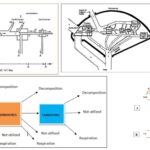IB Biology 14 Views 1 Answers
Sourav PanLv 9November 9, 2024
How does the structure of the human elbow support its function, and what can be annotated on a diagram of this joint?
How does the structure of the human elbow support its function, and what can be annotated on a diagram of this joint?
Please login to save the post
Please login to submit an answer.
Sourav PanLv 9May 15, 2025
The structure of the human elbow supports its function as a hinge joint, allowing for specific movements such as flexion and extension of the forearm while providing stability and strength. Here’s a detailed explanation of how the anatomical features of the elbow contribute to its function, along with key annotations that can be made on a diagram of this joint.
Structure and Function of the Elbow Joint
1. Bones Involved
- Humerus: The upper arm bone that forms the upper part of the elbow joint.
- Ulna: The inner bone of the forearm that articulates with the humerus at the trochlea.
- Radius: The outer bone of the forearm that articulates with the humerus at the capitulum.
2. Joint Type
- The elbow is classified as a synovial joint, specifically a hinge joint, which allows movement primarily in one plane (flexion and extension). This structure enables smooth movement while providing stability.
3. Articulating Surfaces
- The trochlear notch of the ulna fits around the trochlea of the humerus, allowing for flexion and extension.
- The capitulum of the humerus articulates with the head of the radius, enabling some degree of rotation, particularly during pronation and supination.
4. Ligaments
- Ulnar Collateral Ligament (UCL): Located on the inner side, it provides stability to resist valgus forces.
- Radial Collateral Ligament (RCL): Located on the outer side, it stabilizes against varus forces.
- Annular Ligament: Encircles the head of the radius, allowing it to rotate freely while maintaining its position against the ulna.
5. Joint Capsule and Bursae
- The elbow joint is surrounded by a fibrous capsule that contains synovial fluid for lubrication, reducing friction during movement. Bursae, such as the olecranon bursa, help cushion and reduce friction between tendons and bones.
6. Muscle Attachments
- Muscles such as the biceps brachii and triceps brachii attach to bones via tendons, facilitating flexion (biceps) and extension (triceps) at the elbow joint.
Annotations for a Diagram of the Elbow Joint
When annotating a diagram of the elbow joint, consider including:
- Bony Landmarks:
- Label the humerus, ulna, and radius.
- Identify key landmarks such as:
- Trochlea (on humerus)
- Capitulum (on humerus)
- Trochlear notch (on ulna)
- Olecranon process (on ulna)
- Ligaments:
- Highlight and label:
- Ulnar collateral ligament
- Radial collateral ligament
- Annular ligament
- Highlight and label:
- Muscles:
- Indicate major muscles involved in movement:
- Biceps brachii (flexor)
- Triceps brachii (extensor)
- Indicate major muscles involved in movement:
- Joint Capsule:
- Show and label the fibrous capsule surrounding the joint.
- Bursae:
- Identify bursae such as olecranon bursa to illustrate their protective role.
- Movement Arrows:
- Use arrows to indicate possible movements (flexion and extension) around the hinge joint.
- Articulating Surfaces:
- Highlight where bones articulate with each other, showing how they fit together during movement.
0
0 likes
- Share on Facebook
- Share on Twitter
- Share on LinkedIn
0 found this helpful out of 0 votes
Helpful: 0%
Helpful: 0%
Was this page helpful?




